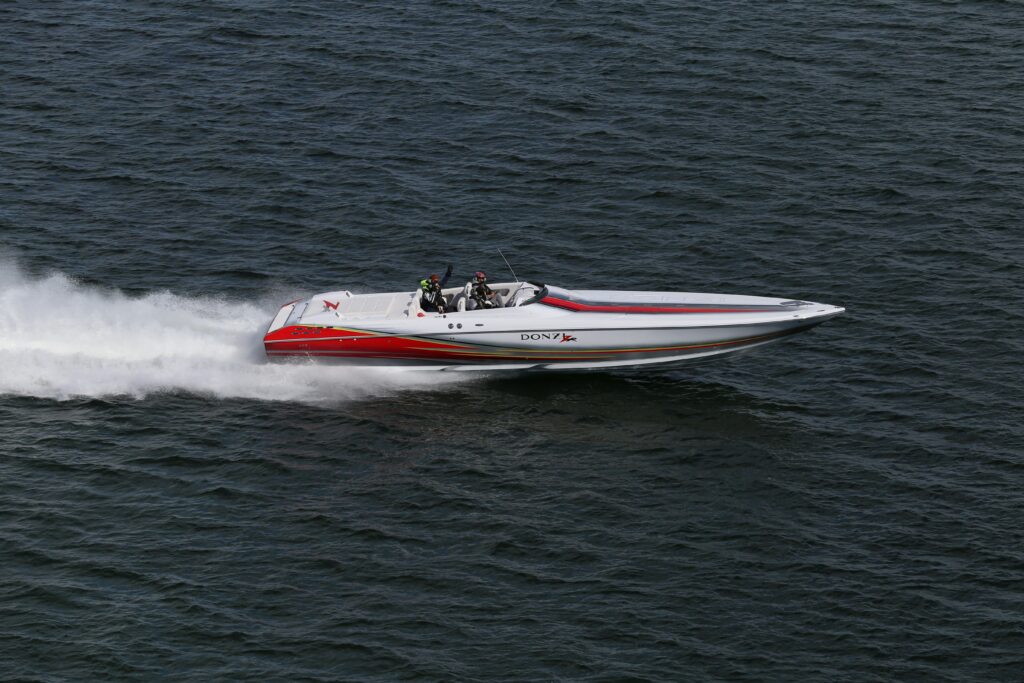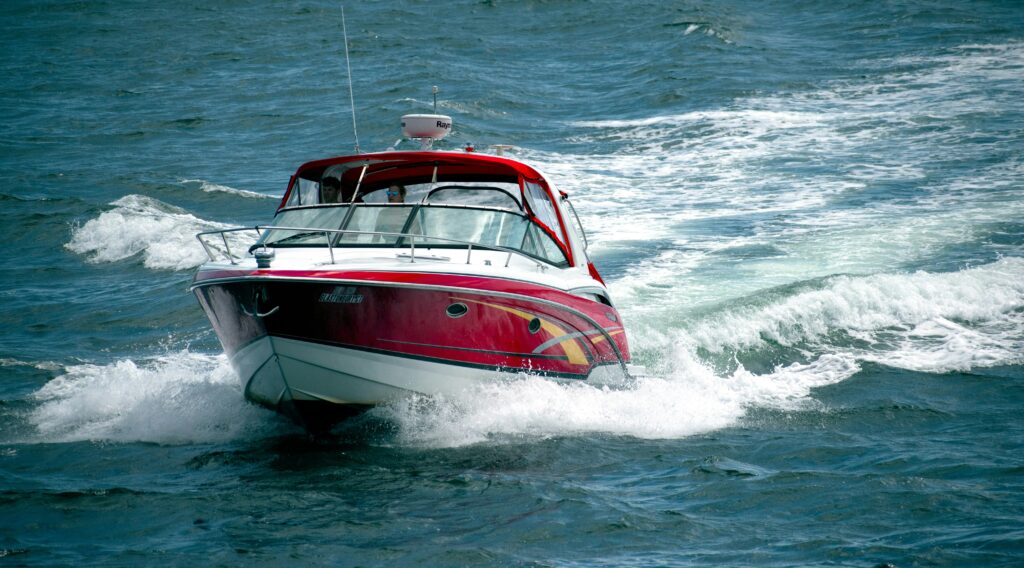Introduction: The Heart Of Your Boat: Choosing The Right Motor
Starting your boating adventure begins with an important choice: picking a motor that matches your needs. When it comes to inboard vs outboard motors, your decision will define the performance and joy you get from your time on the water.
Understanding Inboard vs Outboard Motors
Inboard motors are the hidden powerhouses, typically nestled within the hull of larger vessels. They offer a centralized weight distribution which is great for stability and can manifest in impressive longevity. This kind of motor is known for being less accessible for repairs, given its positioning, but it’s a robust choice if you’re after durability and have a larger boat.
On the flip side, outboard motors are like the Swiss army knives of boat propulsion systems. They’re versatile, easy to service, and perfect for those who like to tinker with their equipment themselves. Because they attach to the boat’s exterior, you gain extra space onboard and can enjoy easier access for any maintenance work. Plus, outboards are the go-to for smaller boats due to their easier handling and lighter weight.
Remember that an outboard motor’s simplicity could serve you well when casting off for a day of fishing or leisure. But the stalwart inboard might be your trusted ally if you’re powering a larger craft, cruising the deep blue, or setting sail on the ocean’s expanse.
So, when it comes down to powering your boat, consider your size needs and activities. Performance on the water isn’t just about speed; it’s about the appropriate matching of boat and motor. Whether you’re considering renowned brands like Mercury, Yamaha, or Honda for your outboard needs, or Volvo and Cummins for inboards, your choice defines your boating experience. Now ask yourself: Are you seeking the ease of an outboard or the hardy endurance of an inboard? Your answer steers the course to your next horizon.
Inboard Motors: Inside The Engine Compartment

When you’re thinking about boats, the heart of the matter often lies with the choice of motor. Let’s peek beneath the decks at the world of inboard motors, where power meets the waves in a seamless blend of engineering and design.
Inboard Motor Basics
Inboard motors are the concealed powerhouses of many boats, designed to sit inside the hull, usually beneath the deck. This location provides a low center of gravity, a feature that’s particularly beneficial for stability and balance on the water.
The Anatomy Of An Inboard Motor
Your typical inboard motor includes the engine, transmission, shaft, propeller, and rudder, all tucked neatly into the boat’s hull. This setup enables direct power to the propeller, with the shaft running straight through the hull to the stern.
Historical Evolution
From early steam-power to today’s high-tech marvels, inboard engines have evolved. Brands like Mercury Marine have been at the forefront, pushing performance and fuel efficiency with engines that showcase decades of innovation.
Advantages Of Inboard Motors
For all you boating enthusiasts, here’s the scoop: inboard motors are known for enhanced handling and control. With the weight deeply ensconced in the hull, they give you a stable ride, even in choppy conditions.
Quieter Boating Experience
One of the joys of boating is a quiet cruise. Inboard motors, nestled within the boat, cut down on noise. It’s the kind of serene escape you can’t help but love.
Ideal For Larger Boats
If you’re thinking big, think inboard. These motors are often the prime pick for larger vessels. The engine’s placement within the hull optimizes space, especially on deck, allowing for a more leisurely layout.
Disadvantages Of Inboard Motors
However, even inboard motors have their cons. One is limited space on deck due to the engine compartment. This might squeeze out some room for activities or storage.
Maintenance Challenges
While inboard motors tout their merits, they can be a headache to service. Getting into the engine compartment is a bit more complicated, making routine maintenance a chore.
Inboard motor enthusiasts often weigh the pros and cons carefully. Understanding the benefits like stability and control alongside the drawbacks such as reduced deck space and complex maintenance is crucial in making an informed decision. When it comes to inboard motors, it’s all about balance – performance coupled with the practicalities of boating life.
Outboard Motors: Power On The Transom

Have you ever peered over the back of a boat and admired the engine hanging off the stern? That’s an outboard motor for you—compact, powerful, and ready to propel you across the water. Whether you’re gearing up for some high-speed fun or a quiet fishing trip, knowing what powers your vessel can make all the difference.
Outboard Motor Basics
Outboard motors are the go-to power source that clamps onto the transom of a boat, making them easily noticeable. They come in a variety of horsepower (HP) ratings, typically from a modest 2.5 HP for small dinghies up to muscular 350 HP engines like those made by Mercury, capable of powering larger craft.
The Components Of An Outboard Motor
An outboard engine is made up of key parts such as the powerhead (engine), propeller, and gearbox. This combination is what allows your boat to cut through the water with ease.
Evolution Of Outboard Motors
From rudimentary beginnings, outboards have evolved tremendously. Modern outboards are marvels of engineering with improved fuel economy and reduced emissions. Sophisticated models even feature computer-controlled systems to optimize performance.
Advantages Of Outboard Motors
One of the main advantages of outboard engines is their versatility. They can be tilted out of the water to avoid corrosion and damage when not in use. Plus, when it comes to giving your boat some extra oomph, the high power-to-weight ratio of outboards is unmatched.
Versatility And Easy Maneuverability
Outboards are a favorite for those looking to easily pilot their boats in various water conditions. Their external placement gives you more control and agility, which is particularly handy during those relaxing fishing trips where precision is key.
Simplified Maintenance
Maintenance of outboard motors is generally straightforward. Thanks to their accessibility, you can carry out service and repairs without too much hassle—a real win for keeping weekend plans on course!
Suitable For Smaller Boats
If you’re the proud owner of a smaller vessel, an outboard is ideal. It’s a compact power solution that doesn’t eat into precious onboard space, leaving more room for you, your gear, and the catch of the day.
Disadvantages Of Outboard Motors
One downside to outboard motors is reduced space efficiency on the stern where the motor attaches to the boat, which can be a trade-off in terms of overall design and aesthetics.
Noise And Vibration
While you’re zipping across the lake, be prepared for some extra noise and vibration. Outboard engines are exposed, which means they tend to be louder compared to their inboard counterparts. This can be a small price to pay for the freedom they provide.
Performance And Handling
If you’re in the market for a boat, understanding the dance between performance and handling of inboard and outboard motors could make or break your decision. Let’s see how these two stack up to keep you ahead of the curve on the water.
Inboard Vs. Outboard Performance
Inboard motors are renowned for their excellent stability because the engine’s weight is centrally located, which lowers the boat’s center of gravity. This is particularly beneficial in larger vessels, such as speed boats and deck boats, where a steady ride is key. Outboards, on the other hand, pack a serious punch in torque—they turn higher rpm, which translates to quick, responsive power.
Speed And Acceleration Comparison
When it comes to speed, this is where outboards often have the edge. Many high-performance outboard engines from brands like Mercury and Yamaha offer superior horsepower-to-weight ratios, which means faster acceleration for you.
Maneuverability In Different Water Conditions
Maneuverability, especially in saltwater or when facing a challenging wake, can be a concern. Here, inboards with their rudder-driven steering offer reliable handling. But don’t underestimate outboard motors—they respond admirably to steering input, providing more agility especially in tight spots.
Turning And Control
In terms of turning and control, an inboard motor’s rudder system allows for smooth, predictable movements. Yet, the inboard/outboard or sterndrive system combines inboard’s control with outboard’s better thrust for a more versatile experience—making them a popular choice among boaters.
Steering Mechanisms And Responsiveness
The steering mechanisms in outboards are inherently more responsive due to the motor being mounted on the transom, allowing for rapid directional change.
Docking And Precision Handling
Finally, docking involves precise handling and control. In this arena, inboards often provide a smoother operation due to a fixed propeller and rudder system. Nevertheless, the immediate power output of outboards might offer a snappier response that can help in quickly correcting a docking approach in a tight marina spot.
Each type of motor caters to different styles and needs on the water. Whether you’re gliding through a calm lake or slicing through coastal waves, your final choice should marry the type of performance and handling that best complements your boating lifestyle.
Space And Layout Considerations

When choosing between an inboard and outboard motor boat, the impact on space and layout is critical. You’ll want to understand how each option affects your use of the boat, from the deck to the cabin.
Deck Space And Configuration
Your boat’s deck space directly influences your boating experience, especially if you love socializing or sunbathing. Outboard motors are mounted on the transom, freeing up the stern area for an extended swim platform or additional seating. In contrast, inboard motors can take up significant space in the middle of the boat, sometimes affecting deck configurations.
Utilizing Deck Space
Maximizing deck space is essential, whether you’re cruising or fishing. Outboard motors provide an unobstructed deck, ideal for pontoon boats which typically have expansive open areas. Inboard boats often have a permanent fixture in the deck’s center to house the motor, which can serve as additional seating or a table base.
Impact On Seating And Amenities
A key question might be, “What can make my family’s time on the water more enjoyable?” Consider that inboard designs often incorporate seating around the motor housing. This can create a cozy cockpit feel, which is great for keeping everyone engaged during a boat ride. Outboards allow a more flexible layout, meaning you can have more room for amenities like outdoor kitchens or fishing gear.
Interior Design And Cabin Space
For those who prioritize indoor comfort, inboard motors accommodate more cabin space. This is essential in larger cabin cruisers where living quarters and storage take precedence. With inboard setups, you’ll usually find more extensive cabins and below-deck amenities, as the motor doesn’t protrude into the cabin area.
Implications For Comfort And Storage
Both inboard and outboard motors have implications for comfort and onboard storage. An inboard motor’s centralized weight distribution can lead to a smoother ride, which is key during rough waters. Inboard designs typically come with built-in storage compartments, whereas inboards might provide more flexible storage solutions for your gear and necessities.
Remember, as you compare deck layouts and interior design, consider how you plan to use your boat. Whether it’s peaceful solo fishing trips or lively family outings, the motor type you choose will shape your boating experience.
Maintenance And Upkeep
Getting your hands dirty or keeping them clean? Your choice of motor—be it inboard or outboard—affects not just your experience on the water but also the maintenance work you’ll need to schedule. Let’s dive into specifics to keep your vessel running smoothly.
Inboard Motor Maintenance
Inboard motors are a bit like the hidden heroes of your watercraft, neatly tucked away. Regular upkeep is crucial, and that means paying attention to the oil levels and the condition of your cooling systems. Did you know that most inboard motors need an oil change after every 100 hours of use? That’s a key stat to remember, brought to us by the folks at Boater’s University.
Engine Compartment Care
Keeping your engine compartment clean is not just about aesthetics—it’s about function. Debris and moisture can lead to corrosion or electrical issues. Be sure to check for water intrusion after each outing and keep bilge pumps and drains clear to prevent unwanted ‘pool’ parties in your boat’s lower levels.
Routine Maintenance Schedule
Grab your calendar because setting a routine maintenance schedule is vital. For inboards, inspections of transmissions and shaft seals should happen bi-annually, as recommended by engine manufacturers. Outboards, on the other hand, are happy with a good servicing at least once a year, prefacing the boating season. Here’s a checklist:
- Inboard: Check transmission, shaft seals, oil, and cooling system bi-annually
- Outboard: Annual service, including gear oil, fuel filters, and pump impellers
Outboard Motor Maintenance
Outboard motors fare well in the fresh air and can be seen and accessed easily, which might explain their friendship with DIY enthusiasts. Outboards demand regular checks, especially looking after the propeller for dings, and the skag for damage from those sneaky underwater obstacles.
Exterior Motor Care
Here’s a fun fact—saltwater and motors have a love-hate relationship. While an outboard motor may enjoy the cool splashes, it won’t be fond of the residue. A good freshwater rinse after each saltwater trip will keep the corrosion at bay.
Routine Maintenance Requirements
A little goes a long way when it comes to maintenance. A schedule for outboard power could include:
- Every trip: Rinse off saltwater (even if you can’t see it! Trust us, it’s there).
- Every 100 hours or annual: Replace spark plugs and fuel filters.
- Every 300 hours or three years: Replace water pump impellers to prevent overheating dramas, as discussed in the 2021 Boat Engine Round-Up Report.
Keep these tips in your toolbox, and your marine adventures will be smooth sailing (or motoring!). Remember, whether inboard or outboard, maintenance costs now can prevent repair costs later.
Fuel Efficiency And Costs

Deciding between inboard and outboard motors for your boat largely hinges on their fuel efficiency and the costs involved. You want to make sure you’re choosing not just a powerful option, but also one that aligns with your budget in the long term.
Fuel Efficiency Comparison
Inboard motors are often seen as workhorses, built within the boat’s hull; they’re generally chosen for larger vessels. While traditionally less fuel-efficient than outboard motors due to increased drag and weight, improvements in technology are narrowing this gap.
In contrast, outboard motors, mounted on the boat’s transom, stand out for their fuel economy. Many modern outboards are designed to provide better fuel efficiency, thanks to advancements in technology and lighter materials. This means that, for many boats, an outboard might be the more budget-friendly option when it comes to fuel consumption.
Consumption Rates And Fuel Types
The type of fuel used by inboard and outboard motors can also impact efficiency. Typically, outboards run on gasoline, which can differ in price and consumption rates depending on the engine size and design. It’s not uncommon to find smaller outboards that are impressively fuel-efficient, offering a great balance of power without guzzling gas.
Inboard engines might use diesel or gasoline, and while diesel has a reputation for efficiency, the initial cost and maintenance could offset such benefits. Moreover, specific brands are associated with distinct consumption rates and fuel types, with the likes of Mercury and Yamaha often leading the charge with innovative, efficient outboard options.
Cost Of Operation Analysis
When it comes to operating costs, you’re looking at more than just fuel. Maintenance, repairs, and even insurance play a role. Outboard motors typically incur lower maintenance costs due to better accessibility for repairs.
Furthermore, efficiency isn’t just about the fuel. It’s about how the engine uses that fuel. Outboard engines can boast an excellent power-to-weight ratio, making them not just easier on the fuel but on your wallet too—a crucial consideration for boaters watching their bottom line. On the other hand, while inboards might come with a higher cost of operation, their durability and lifespan could provide value over time, as noted by Handler.
Choosing The Right Motor For Your Boat
When deciding between an inboard and outboard motor for your boat, there are several key factors to consider. From the type of boating you plan to do to the size of your vessel and budget, each aspect plays a pivotal role.
Determining Factors
Boat Size and Type:
- Inboard Motors: Recommended for larger, cabin cruisers and fishing boats which may require more power and a lower center of gravity.
- Outboard Motors: Ideal for small to mid-sized boats, such as pontoon boats, where increased deck space and simpler maintenance are significant advantages.
Boat Size And Type
Selecting the correct motor starts with your boat’s specifics. Larger boats benefit from the increased power and stability of inboards, whereas smaller craft often opt for outboards for their ease of access and added space.
- For fishing boats, consider where you’ll be casting off — shallow water may call for the tilting capabilities of an outboard.
- Pontoon boats tend to fare well with outboards for leisure cruises and family outings.
Boating Activities And Preferences
Your preferred boating activities influence motor choice. High-speed watersports or tranquil fishing? Each motor has its merits.
- Watersports: The thrust and quick acceleration of outboards can make them a top pick for this niche.
- Personal Preference: Ease of control and service may steer you towards an outboard, while the appeal of a quieter, more integrated inboard could align with your vision for your vessel.
Budget And Cost Considerations
How much are you willing to invest initially and over the lifespan of your boat? Outboards generally have a lower initial cost but can have higher maintenance costs. When considering budget and cost considerations, think long-term as well.
- Initial Investment: Outboards can be less pricey upfront.
- Long-Term Costs: Inboard engines may cost more initially but could offer savings down the line with potentially longer lifespans and less frequent servicing needs.
Initial Investment And Long-Term Costs
Long-term ownership costs such as maintenance and potential repairs are just as crucial as the initial sticker price. Understanding the ins and outs of each motor type helps you prepare for the future.
- Outboards: Known for easier and sometimes more frequent service.
- Inboards: Generally require more significant initial investment but can be more durable over many years.
Choosing the right motor for your boat is a blend of practicality and personal preference. From the thrill of watersports to relaxing fishing trips, the engine beneath your deck plays a crucial role in your boating satisfaction and success. Consider your boating activities, boat size, and budget carefully to ensure years of enjoyable and reliable boating.
Environmental Impact

When it comes to the waters you love, the choice between inboard and outboard motors isn’t just about performance—it’s about the planet. Your decision has a ripple effect on our environment, influencing emissions, potential pollution, and the path towards eco-friendly innovations.
Environmental Considerations
In the debate of inboard vs. outboard motors, it’s crucial to consider their environmental impact. Inboards are typically similar to car engines, which means they often use less fuel but might be heavier. Outboards, on the other hand, are known for being lighter and more fuel-efficient in smaller applications.
Eco-Friendly Alternatives
Exciting news for you, eco-conscious sailors! Hybrid and electric motors are sailing onto the scene, offering promising alternatives with minimal emissions. Brands like Torqeedo have pioneered electric outboards, and companies such as Yanmar have developed hybrid technologies for inboards, which substantially reduce emissions and improve fuel efficiency. While upfront costs may be higher, these options represent steps toward a greener horizon for the boating industry.
FAQs (Frequently Asked Questions)
Navigating the waters of boat motors can raise a swell of questions. Here’s a quick dive to clarify some of those bubbling curiosities.
What Are The Main Differences Between Inboard And Outboard Motors?
Inboard motors are built inside the boat’s hull and generally offer a smoother, quieter ride, ideal for luxury cruising. Outboard motors, on the other hand, are mounted on the stern and can be raised or lowered – giving you versatility and ease of maintenance. The key differences lie in placement, size, and accessibility.
Which Is Better For Water Sports, Inboard Or Outboard Motors?
For water sports enthusiasts, inboard motors, particularly inboard tow boats, are typically the popular choice due to their ability to create a consistent wake. For instance, the Malibu Boats line-up is renowned among water skiing and wakeboarding circles for its top-notch performance and killer wakes. Outboard motors might kick up a fuss with agility, but inboards bring the wave-shaped party.
How Do I Decide Which Motor Type Is Right For My Boat?
Decision-making here hinges on your boat’s intended use. If you’re all about fishing or day trips, and appreciate a good tango with maneuverability, then outboard motors might just be your sea-shanty. However, if luxurious yachting or water sports are beckoning, then inboard motors are likely to steer you right.
Are Outboard Motors More Fuel-Efficient Than Inboard Motors?
When it comes to fuel efficiency, outboard motors typically get the upper hand. Recent advancements like Yamaha’s four-stroke outboards have raised the bar, churning out impressive fuel economy numbers. Yet, don’t forget that efficiency can vary depending on motor size and the captain’s handling.





